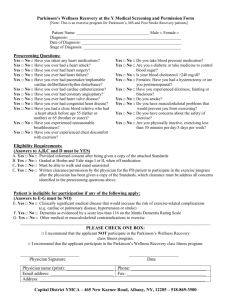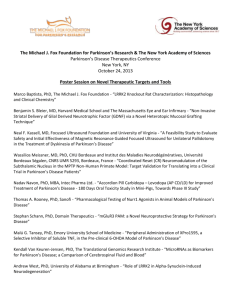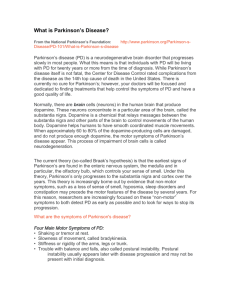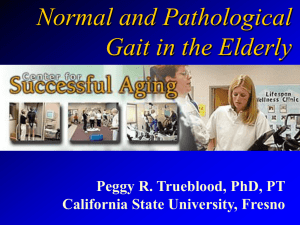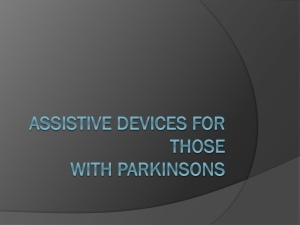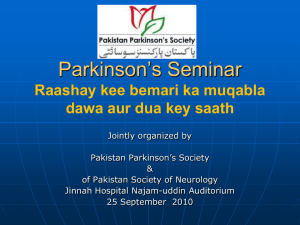טיפול בהפרעות הליכה במחלת פרקינסון מחלת פרקינסון משפיעה על יכולת
advertisement
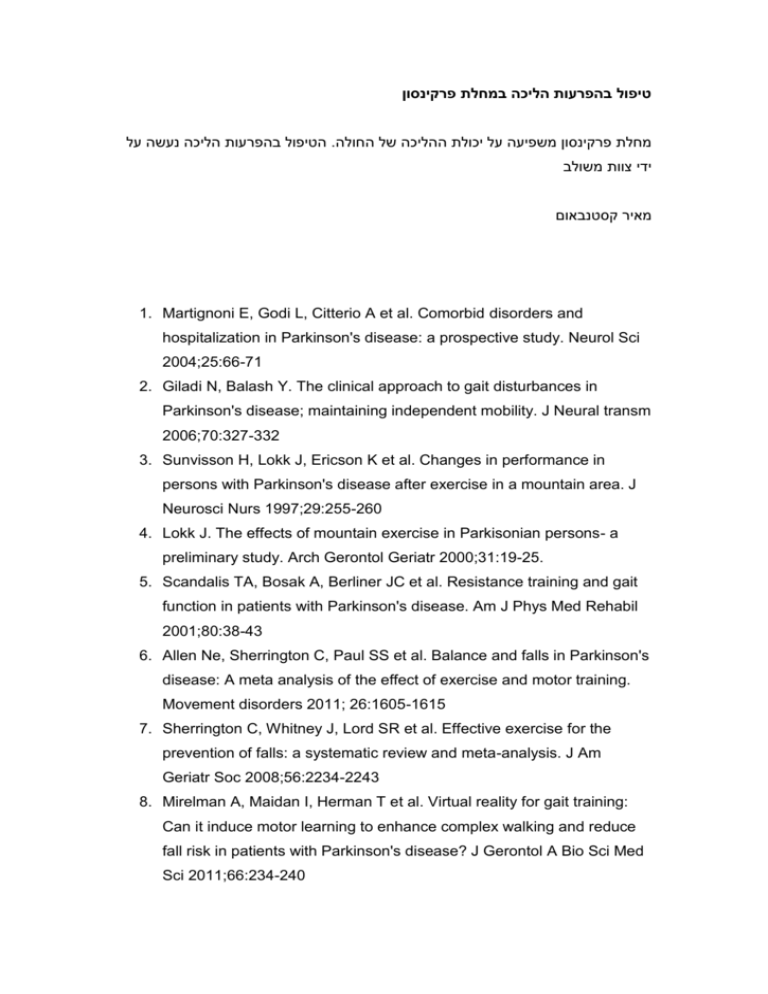
טיפול בהפרעות הליכה במחלת פרקינסון הטיפול בהפרעות הליכה נעשה על.מחלת פרקינסון משפיעה על יכולת ההליכה של החולה ידי צוות משולב מאיר קסטנבאום 1. Martignoni E, Godi L, Citterio A et al. Comorbid disorders and hospitalization in Parkinson's disease: a prospective study. Neurol Sci 2004;25:66-71 2. Giladi N, Balash Y. The clinical approach to gait disturbances in Parkinson's disease; maintaining independent mobility. J Neural transm 2006;70:327-332 3. Sunvisson H, Lokk J, Ericson K et al. Changes in performance in persons with Parkinson's disease after exercise in a mountain area. J Neurosci Nurs 1997;29:255-260 4. Lokk J. The effects of mountain exercise in Parkisonian persons- a preliminary study. Arch Gerontol Geriatr 2000;31:19-25. 5. Scandalis TA, Bosak A, Berliner JC et al. Resistance training and gait function in patients with Parkinson's disease. Am J Phys Med Rehabil 2001;80:38-43 6. Allen Ne, Sherrington C, Paul SS et al. Balance and falls in Parkinson's disease: A meta analysis of the effect of exercise and motor training. Movement disorders 2011; 26:1605-1615 7. Sherrington C, Whitney J, Lord SR et al. Effective exercise for the prevention of falls: a systematic review and meta-analysis. J Am Geriatr Soc 2008;56:2234-2243 8. Mirelman A, Maidan I, Herman T et al. Virtual reality for gait training: Can it induce motor learning to enhance complex walking and reduce fall risk in patients with Parkinson's disease? J Gerontol A Bio Sci Med Sci 2011;66:234-240 9. Li F, Harmer P, Fitrgerald K et al. Tai Chi and postural stability in patients with Parkinson's disease. N Engl J Med 2012;366:511-519 10. Tomlison CL, Patel S, Meek C et al. Physiotherapy intervention in Parkinson's disease: systematic review and meta-analysis 2012 11. Mazoteras Munoz V, Abellan van Kan G, Cantet C et al. Gait and balance impairments in Alzheimer disease patients. Alzheimer Dis Assoc Disord 2010;1:79-84 12. Tanaka, K, Quadros AC JR, Santos RF et al. Benefits of physical exercise on executive functions in older people with Parkinson’s disease. Brain Cogn 2009; 69: 435–441 13. Cruise, KE, Bucks RS, Loftus AM et al. Exercise and Parkinson’s: benefits for cognition and quality of life. Acta Neurol. Scand 2011;123:13-19 14. Lautenschlager NT, Cox KL, Flicker L. et al. Effect of physical activity on cognitive function in older adults at risk for Alzheimer disease: a randomized trial. JAMA 2008; 300:1027–1037 15. Larson EB, Wang L, Bowen JD et al. Exercise is associated with reduced risk for incident dementia among persons 65 years of age and older. Ann. Intern. Med. 2006;144, 73–81 16. Andersen H. Motor dysfunction in diabetes. Diabetes Metab Res Rev 2012;28:89-92 17. McGraw B, McClenaghan BA, Williams HG et al. Gait and postural stability in obese and nonobese prepubertal boys. Arch Phys Med Rehabil 2000;81:484-489 18. Lorefalt B, Toss G, Granerus AK. Bone mass in elderly patients with Parkinson’s disease. Acta Neurol. Scand 2007;116:248–254 19. Invernizzi M, Carda S, Viscontini GS et al. Osteoporosis in Parkinson’s disease. Parkinsonism Relat. Disord 2009;15:339–346 20. Riedel O, Klotsche J, Spottke J et al. Frequency of dementia, depression, and other neuropsychiatric symptoms in 1,449 outpatients with Parkinson’s disease 2010. J. Neurol. 257, 1073–1082 21. Stallibrass, C. et al. Randomized controlled trial of the Alexander technique for idiopathic Parkinson’s disease. Clin. Rehabil. 16, 695– 708 (2002). 22. Schmitz-Hubsch, T. et al. Qigong exercise for the symptoms of Parkinson’s disease: a randomized, controlled pilot study. Mov. Disord. 21, 543–548 (2006). 23. Goodwin, V. A. et al. The effectiveness of exercise interventions for people with Parkinson’s disease: a systematic review and metaanalysis. Mov. Disord. 23, 631–640 (2008). 24. Jantti PO, Pyykko I, Laippala P. Prognosis of falls among elderly nursing home residents. Aging 1995;7:23-27 25. Whooley MA, Kip KE, Cauley JA et al. Depression, falls, and risk of fracture in older women. Study of Osteoporotic Fractures Research Group. Arch Intern Med 1999;159:484-490 26. Lenze EJ, Munin MC, Dew MA et al. Adverse effects of depression and cognitive impairment on rehabilitation participation and recovery from hip fracture. Int J Geriatr Psychiatry 2004;19:472-478 27. Speelman AD, Warrenburg BP, Nimwegen M, et al. How might physical activity benefit patients with Parkinson disease? Nature Reviews Neurology 2011;7:528-534. 28. Giladi N, Shabtai H, Rozenberg E et al. Gait festination in parkinson's disease. Parkinsonism and Relat Disord 2001;7:135-138 29. Tohgi H, Abe T, Takahashi S. The effects of L-threo-3,4dihydroxyphenylserine on the total norepinephrine and dopamine concentrations in the cerebrospinal fluid and freezing gait in parkinsonian patients. J Neural Transm Park Dis Dement Sect 1993;5:27–34. 30. Auriel E, Hausdorff JM, Herman T et al. Effects of methylpgenydate on cognitive function and gait in patients with Parkinson's disease: a pilot study. Clin Neuropharmacol 2006;29:15-17 31. Pollak L, Dobronevsky Y, Prohorov T et al. Low dose methylphenidate improves freezing in advanced Parkinson's disease during off-state. J Neural Transm Suppl 2007;72:145-148 32. Devos D, Krystowiak P, Clement F, et al. Improvement of gait by chronic high dose of methylphenidate in patients with advanced Parkinson's disease. J Neurol Neurosurg Psychiatry 2007;78:470-475 33. Moreau C, Delval A, Defebure L et al. Methylphenidate for gait hypokinesia and freezing in patients with Parkinson's disease undergoing subthalamic stimulation: a multicentre, parallel, randomized, placebo-controlled trial. Lancet Neurol 2012;11:589-596 34. Rubenstein TC, Giladi N, Hausdorff JM. The power of cueing to circumvent dopamine deficits: a review of physical therapy treatment of gait disturbances in Parkinson’s disease. Mov Disord 2002;17:1148 –1160. 35. Kamsma YP, Brouwer WH, Lakke JPWF. Training of compensation strategies for impaired gross motor skills in Parkinson’s disease. Physiother Theory Pract 1995;11:209 –229. 36. Miyai I, Fujimoto Y, Yamamoto H, et al. Long-term effect of body weight-supported treadmill training in Parkinson’s disease: a randomized controlled trial. Arch Phys Med Rehabil 2002;83: 1370– 1373. 37. Schenkman M, Cutson TM, Kuchibhatla M, et al. Exercise to improve spinal flexibility and function for people with Parkinson’s disease: a randomized, controlled trial. J Am Geriatr Soc 1998;46:1207–1216. 38. Nieuwboer A, de Weerdt W, Dom R, Truyen M, Janssens L, Kamsma YP. The effect of a home physiotherapy program for persons with Parkinson’s disease. J Rehabil Med 2001;33:266–272. 39. Rocchi L, Chiari L, Horak FB. Effects of deep brain stimulation and levodopa on postural sway in Parkinson’s disease. J Neurol Neurosurg Psychiatry 2002;73:267–274. 40. Stolze H, Klebe S, Poepping M, et al. Effects of bilateral subthalamic nucleus stimulation on parkinsonian gait. Neurology 2001; 57:144 – 146. 41. Faist M, Xie J, Kurz D, et al. Effect of bilateral subthalamic nucleus stimulation on gait in Parkinson’s disease. Brain 2001; 124:1590 – 1600. 42. Bronte-Stewart HM, Minn AY, Rodrigues K, Buckley EL, Nashner LM. Postural instability in idiopathic Parkinson’s disease: the role of medication and unilateral pallidotomy. Brain 2002;125: 2100–2114. 43. Maurer C, Mergner T, Xie J, Faist M, Pollak P, Lucking CH. Effect of chronic bilateral subthalamic nucleus (STN) stimulation on postural control in Parkinson’s disease. Brain 2003;126:1146–1163. 44. Yokoyama T, Sugiyama K, Nishizawa S, Yokota N, Ohta S, Uemura K. Subthalamic nucleus stimulation for gait disturbance in Parkinson’s disease. Neurosurgery 1999;45:41– 47. 45. Kumar R, Lozano AM, Sime E, Halket E, Lang AE. Comparative effects of unilateral and bilateral subthalamic nucleus deep brain stimulation. Neurology 1999;53:561–566. 46. Welter ML, Houeto JL, Tezenas du Montcel S, et al. Clinical predictive factors of subthalamic stimulation in Parkinson’s disease. Brain 2002;125:575–583.

